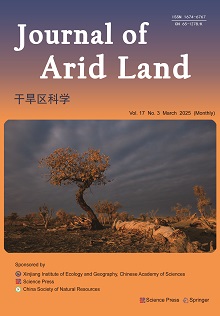|
|
Spatial heterogeneity of soil chemical properties between Haloxylon persicum and Haloxylon ammodendron populations
CongJuan LI, Yan LI, Jian MA, LianLian FAN, QinXue WANG
Journal of Arid Land
DOI: 10.3724/SP.J.1227.2010.00257
Spatial heterogeneity is a ubiquitous feature in natural ecosystems, especially in arid regions. Different species and their discontinuous distribution, accompanied by varied topographic characteristics, result in soil resources distributed differently in different locations, and present significant spatial heterogeneity in desert ecosystems. In this study, conventional and geostatistical methods were used to identify the heterogeneity of soil chemical properties in two desert populations, Haloxylon persicum Bunge ex Boss., which dominates on the slopes and tops of sand dunes and Haloxylon ammodendron (C. A. Mey.) Bunge, which inhabits interdunes in the Gurbantunggut Desert of Xinjiang, China. The results showed that soil pH, electrical conductivity (EC), soil organic carbon (SOC), available nitrogen (AN) and available phosphorus (AP) were significantly higher in H. ammodendron populations than that in H. persicum. The coefficient of variation (CV) indicated that (1) most parameters presented a moderate degree of variability (10% < CV < 100%) except pH in both plots, (2) the variability of soil pH, EC and AP in H. ammodendron populations was higher than that in H. persicum populations, and (3) SOC and AN in H. ammodendron populations were lower than that in H. persicum populations. Geostatistical analysis revealed a strong spatial dependence (C0/(C0+C) < 25%) within the distance of ranges for all tested parameters in both plots. The Kriging-inter-polated figures showed that the soil spatial distribution was correlated with the vegetation distribution, individual size of plants, and the topographic features, especially with the plants nearest to sampling points and the topographic features. In each plot, soil EC, SOC, AN and AP presented similar distributions, and fertile islands and salt islands occurred in both plots but did not affect every individual plant, since the sampling distance was larger than the size of such fertile islands. The results of topographic effects on soil heterogeneity suggested significant differences between the interdunes and dune-tops. Different topographic characteristics (physical factors) between plots result in the differences in SOC, AN and AP, while the heterogeneity of soil pH and EC arise from plant species and their distribution (biotic factor). Such biotic and physical factors did not occur in isolation, but worked together on soil heterogeneity, and played important parts in improving the soil properties. Hence these factors were ecologically valuable in the highly resource-stressed arid study area.
Related Articles |
Metrics |
Comments(0)
|
|
 IF(JCR): 2.7 (Q3)
IF(JCR): 2.7 (Q3)